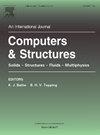3D-printed concrete fracture: Effects of cohesive laws, mixes, and print parameters in 3D eXtended FEM
IF 4.8
2区 工程技术
Q1 COMPUTER SCIENCE, INTERDISCIPLINARY APPLICATIONS
引用次数: 0
Abstract
Unlike conventional concrete fractures, few models of 3D-printed concrete (3DPC) fractures have been reported; moreover, systematic validation across diverse tests, materials, and laboratories is lacking. This paper first reviews existing 3DPC fracture simulations against experiments, noting mixed performance in most cases. Additionally, current models often require excessive material parameters that can be difficult to measure and interpret, along with a scarcity of 3D modeling. To address these issues, the paper develops a robust 3D validation framework using the generalized/eXtended finite element method to simulate both interlayer bonds and intralayer fractures in 3DPC/cementitious materials. Four softening models were assessed by capturing linear and nonlinear fracture responses under tensile, bending, and shear tests. Different 3DPC mixtures (plain, fiber-reinforced, and limestone-calcined clay) from existing experimental studies across different laboratories were used for validation, showing good agreement with experimental load–displacement behavior. The influences of layer print interval and nozzle standoff distance from two separate tests were investigated, revealing that the bilinear cohesive model provided the most consistent predictions for plain and fiber-reinforced 3DPC under tension and bending. In contrast, the Park–Paulino–Roesler and Xu–Needleman cohesive models better captured fracture behavior for the limestone-calcined clay mix, while the linear cohesive model was most suitable for shear mode. A fracture in a topologically optimized 3DPC girder was also simulated, illustrating the method’s applicability to large-scale structural elements, the importance of the material mix, and highlighting a scenario where 2D approximations are inapplicable.
3D打印混凝土断裂:三维扩展有限元中内聚规律、混合料和打印参数的影响
与传统的混凝土裂缝不同,3d打印混凝土(3DPC)的裂缝模型很少被报道;此外,缺乏跨不同测试、材料和实验室的系统验证。本文首先将现有的3DPC裂缝模拟与实验进行了对比,发现大多数情况下的性能好坏参半。此外,目前的模型通常需要过多的材料参数,难以测量和解释,以及缺乏3D建模。为了解决这些问题,本文开发了一个强大的3D验证框架,使用广义/扩展有限元方法来模拟3DPC/胶凝材料的层间键和层内裂缝。通过捕捉拉伸、弯曲和剪切试验下的线性和非线性断裂响应来评估四种软化模型。来自不同实验室现有实验研究的不同3DPC混合物(普通、纤维增强和石灰石煅烧粘土)被用于验证,显示出与实验载荷-位移行为良好的一致性。结果表明,双线性内聚模型对平面和纤维增强3d打印材料在拉伸和弯曲作用下的预测结果最为一致。相比之下,Park-Paulino-Roesler和Xu-Needleman黏结模型更能捕捉灰岩-煅烧粘土混合料的断裂行为,而线性黏结模型最适合剪切模式。此外,还对拓扑优化后的3DPC梁的断裂进行了模拟,说明了该方法对大型结构元件的适用性、材料组合的重要性,并突出了2D近似不适用的场景。
本文章由计算机程序翻译,如有差异,请以英文原文为准。
求助全文
约1分钟内获得全文
求助全文
来源期刊

Computers & Structures
工程技术-工程:土木
CiteScore
8.80
自引率
6.40%
发文量
122
审稿时长
33 days
期刊介绍:
Computers & Structures publishes advances in the development and use of computational methods for the solution of problems in engineering and the sciences. The range of appropriate contributions is wide, and includes papers on establishing appropriate mathematical models and their numerical solution in all areas of mechanics. The journal also includes articles that present a substantial review of a field in the topics of the journal.
 求助内容:
求助内容: 应助结果提醒方式:
应助结果提醒方式:


